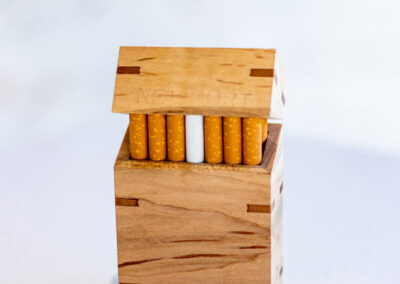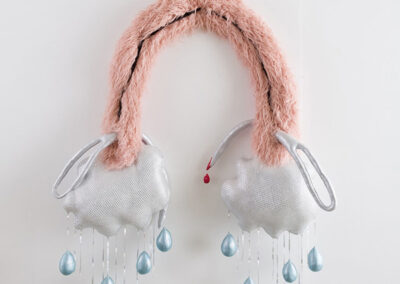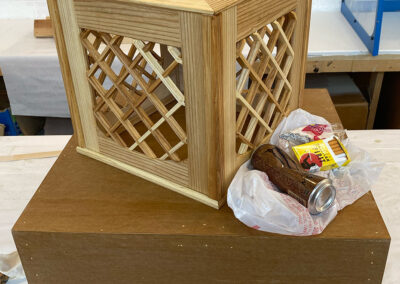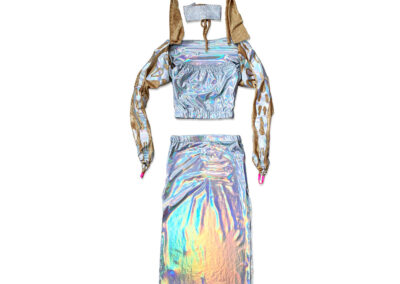Interview with Benjamin Yacavone and Kayle Karbowski
Written by Lee Judilla ’24, gallery assistant at MIAD Gallery at The Ave.
Working at the periphery of student life, staff members hold technical and administrative positions that allow for the smooth operation of the college’s day-to-day and long-term activities. When they’ve clocked out of the MIAD building, they’re home, in the studio, outside in nature– and exercising their own creative muscles and sustaining personal arts practices. “After Hours,” the Milwaukee Institute of Art & Design (MIAD) Gallery at the Ave’s latest exhibition is the first of its kind for the college where staff talents are in the limelight.
In a corner of the exhibition area where giant bay windows welcome sunshine into the space lie two bodies of work whose materiality and subject matter both contrast and compliment each other. On the left sit two pieces that are at first modest in presentation and inconspicuous in form.
Benjamin Yacavone (he/him), a 2016 Masters program graduate of the Columbus College of Art and Design is the artist behind the two works “Morning Break” (2023) and “Box o’ Boges” (2021) that recreate everyday objects into pieces of fine woodworking and craftsmanship. Yacavone is also a MIAD 3D Lab Supervisor, whose practice of woodworking techniques is supplemented by his work environment.
Unvarnished, to-scale constructions of natural wood sit as a milk crate in the former work, and a cigarette box in the latter. Accompanied by found objects like plastic bags, an energy drink can and rolled cigarettes, Yacavone’s work conjures a ghostly image of a blue-collar laborer who is wholly absent and both physically and fiscally incapable of using the objects associated with their brief moment off the clock.
JUDILLA: What led you to examine the consumerism and fetishization surrounding blue-collar America?
YACAVONE: It really started in my late 20’s when I went through an identity crisis and felt like I needed to shape my “look”. I had just come off of a long stint of being couch-ridden due to a broken leg and surgery, and with the change in my body, being out of school and trying to get a job, I had no idea how to dress or what fit my body. The more I searched and tried things, the more I got frustrated with how poorly things were made and how they didn’t fit me well.
This led me to pursue higher end goods, getting into American heritage, raw denim, goodyear welt boots, that type of thing. The whole mantra in that fashion world is “buy fewer, better things” and “buy it once, buy it for life”, or “buy it to fix it”. It was the type of thing my dad actually practiced – he’s had the same couple work coats, same boots, wears the same jeans and sweatshirts pretty much his whole adult life, and I admired that. I wanted to find my “uniform”, and have it last.
All these brands were pushing “inspired by the way things used to be”, modeling off of Levis models, Carhartt silhouettes, all while charging a premium that nobody that the brands were started for could afford. It was blue collar cosplay, and I was a prime contributor.
People are out there chasing the look of their dad or grandpa’s jacket, but paying 3 times as much for something and then intentionally trying to distress it so it looks better, instead of just doing what their dad or grandpa did, which was…wear the clothes. All so that someone can look blue collar, without having to be blue collar. It’s a weird, crazy, hypocritical cycle, and I’m very guilty of being a part of it.
I’m really interested in the dialogue that your woodworking creates in sharp contrast to the mass-produced forms of the referenced objects. What are your considerations when using wood to recreate these already existing items?
I am a woodworker; it’s a medium and material I understand, and I can make it (mostly) into whatever type of final product I’m thinking of for a piece.
Using wood and woodworking/furniture techniques takes away the practicality and accessibility of the mass produced objects that they mirror. Milk crates are everywhere, because they are produced in the hundreds of thousands every day. Same thing with cigarette packs. They’re accessible to everyone on some level or another.
Making these objects out of wood takes all of that away, much like the fetishization of blue collar is taking away the things I talked about in the previous question. Sure, a milk crate made of ash with half lap joinery, cabinet door sides and a linseed oil finish looks nice, but that’s all it can do. Most people who need a milk crate would see the price of my milk crate and think it’s ridiculous.
Does your position as a MIAD 3D Lab Supervisor influence or shape the ways that you make and think about creating work? How?
Working in the 3D lab with my other supervisors, I’ve learned an immense amount about making and woodworking, and that has greatly improved the practical quality of my works. I just know how to make things better than I did before becoming a supervisor, and that knowledge has helped me explore new types of work for my practice.
That knowledge is a double edged sword, and comes with a “bad influence”. I know the “right way” to do things, and now when I think about forms or pieces to explore, I find myself getting hung up on the practicality of how I’d make it, vs. just figuring out how to make it work like I used to. I don’t regret learning and becoming a better maker whatsoever, but I do miss that bit of “ignorance is bliss” part of my practice.
On the right of Yacavone’s two pieces is a body of work that glitters and glows through both night and day. Expansive in medium and visual allure, Kayle Karbowski’s (she/they) work is an invitation to indulge in bright aesthetic pleasure and otherworldly knowledge.
In “Rosacea” (2023), a familiar apple core is turned alien through the help of 3D scanning and glitter fixing. “Costume from Banana (Snake Goddess)” (2018-20), lifted from their video performance at The Future (Minneapolis, MN) art witch residency, utilizes holographic spandex to craft the outfit of a goddess inspired by Britney Spears’s albino python from the year 2000. “Astraea” (2023), another textile piece, utilizes natural dyeing techniques and places it in contrast to the photographic sheen of a digital inkjet print.
Karbowski, ‘15 (Integrated Studio Arts) is a multidisciplinary artist and owner of psychospiritual consultancy and technoapothecary Other Dust. She’s also MIAD’s Rapid Prototyping Technician and an adjunct professor, fostering student art practices in tandem with her own.
JUDILLA: I’m extremely drawn to the mystical logic that your work operates on. They are objects that feel as if they were magically born into our reality. Rosaceae, for example, feels both alien and yet so incredibly familiar. As an intuitive, desire-driven maker, how do you begin to conceptualize your work?
KARBOWSKI: Most of my work begins with a draw I feel towards a specific material, image, or object and a desire to bring it into reality or shift my interpretation of its reality … Work is being conceptualized as I’m making it. I’m always doing lots of research on various topics and getting into new “hobbies.” Through exposure, my mind and my body and my spirit turn them into something new to me. And I just trust that. I just let that be the case and it makes me feel beautiful and free.
I think the magical and alien yet familiar quality of my work comes from this intuitive processing– the work is created by me following threads, but not necessarily tying them together in a nice bow. Concepts and inspiration run parallel to each other instead of explaining each other. I show, I reveal. I don’t tell.
We aren’t allowed to be truly enchanted much in our current world, and I want to reclaim my ability to be enchanted. To be enchanted is to believe everything has an inherent right to just be and to know that it is beautiful. Everything sparkles.
In your work, you use both organic and inorganic materials, ie., holographic spandex vs. naturally dyed cotton. What informs these material choices?
A consequence of being an artist, animist and having a seemingly unending desire to pick up new interests is that I end up collecting a lot of stuff around me all the time. At the same time, I have a deep love for fluorescent, bright and sparkly things– I’m guilty of letting my goblin pleasures and the aesthetic of my childhood drive my color and material choices often.
My flower essence practice has driven me towards finding other ways to hold and express plant energetics as well. While most of this plant matter loses some of its glamor through drying and aging, I find they emit the same holographic, glittering and glowing energies as some of the inorganic materials I work with.
Does your position as a Rapid Prototyping Technician and Emerging Technology Center (ETC) Supervisor influence the ways that you make and think about creating artwork? How?
10000000% absolutely! Work is where I spend the majority of my waking hours, so yes, work and my dreams have a heavy influence on how I think about my (art)work and what I have access to. There are processes that are at my fingertips everyday that it’s my literal job to investigate and share. I appreciate that I get to teach in a lab setting because labs lack hierarchy that classrooms inherently have to have. What I learn is meant to be shared and same with what students and staff and other faculty learn in that space. Interestingly, I feel like my work has become less “digital” in material or process overall but more technological in how I think or approach concepts.
It also feels important to say here that the research we are doing on AI in the ETC has been a humbling and exciting avenue to explore, particularly when it comes to how we understand and teach creativity. I feel like that research has helped give me an ability to pull back a sense of ownership or sense of importance of myself as an “Artist” and become more curious about how I know what I know and what makes me believe what I believe.
“After Hours” is on display now until October 7th. MIAD Gallery at the Ave is open 11am-5pm, Tuesday through Saturday. Learn more at galleryattheave.miad.edu and read more about the exhibiting artists.




